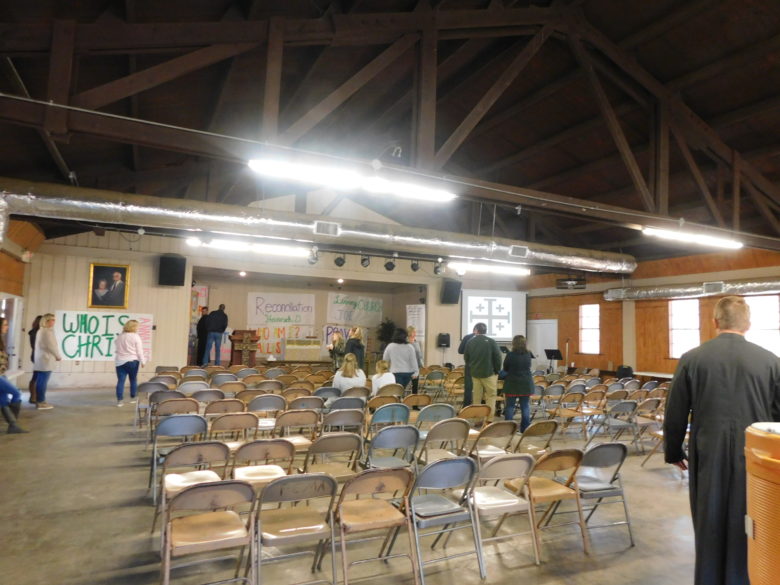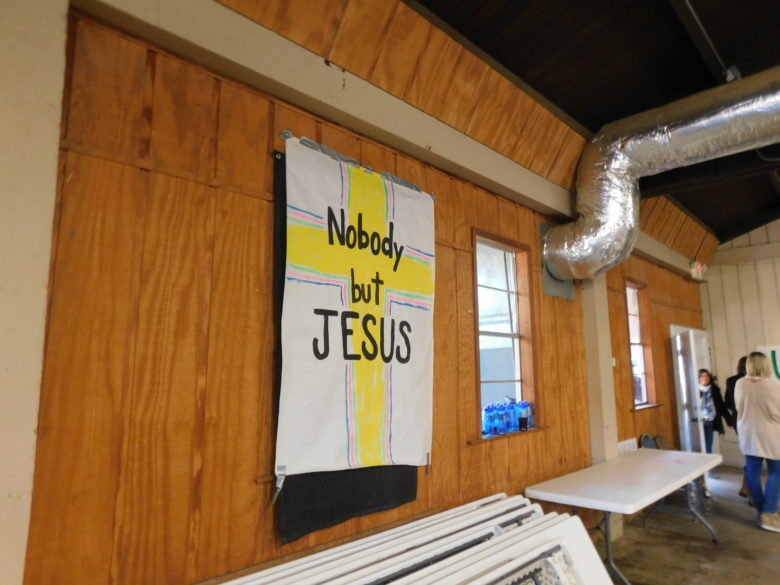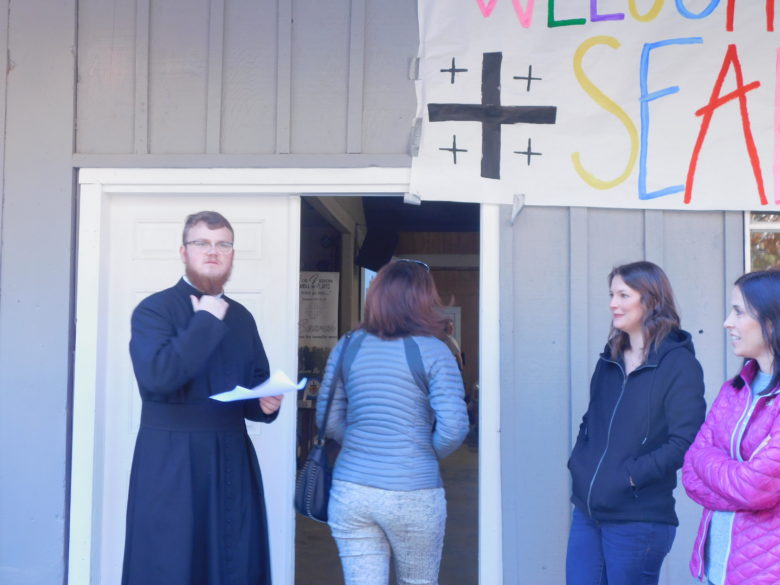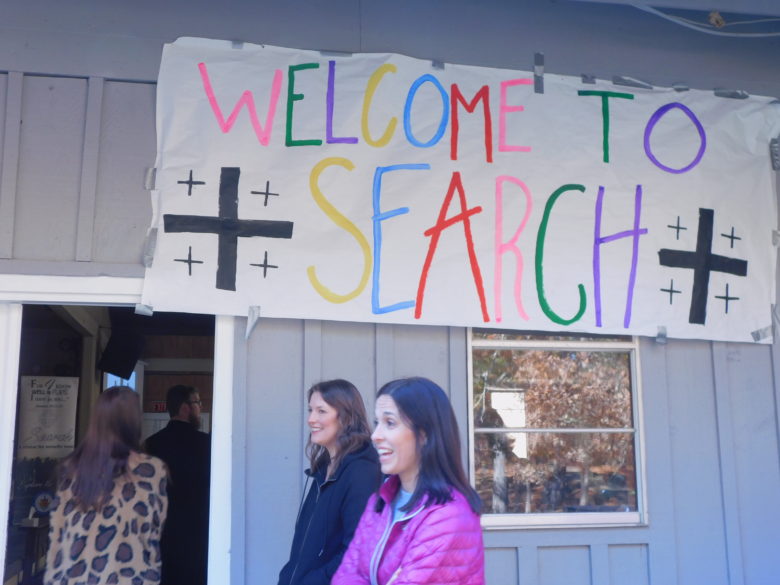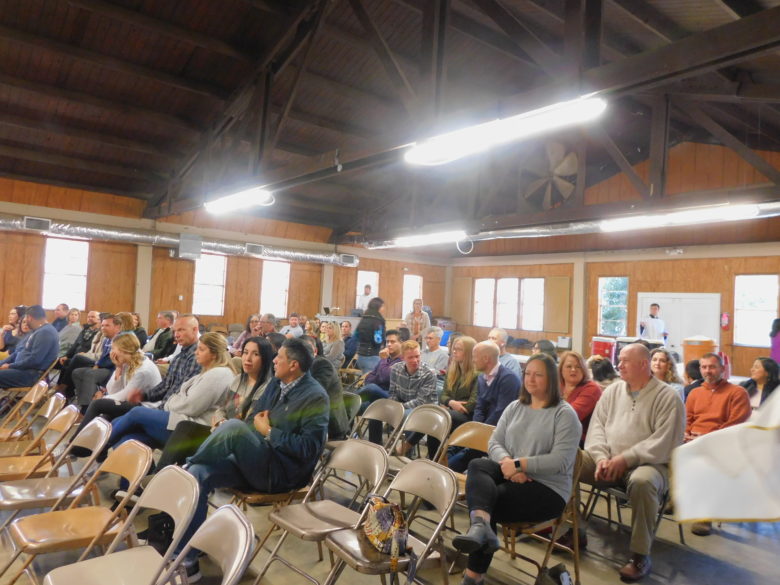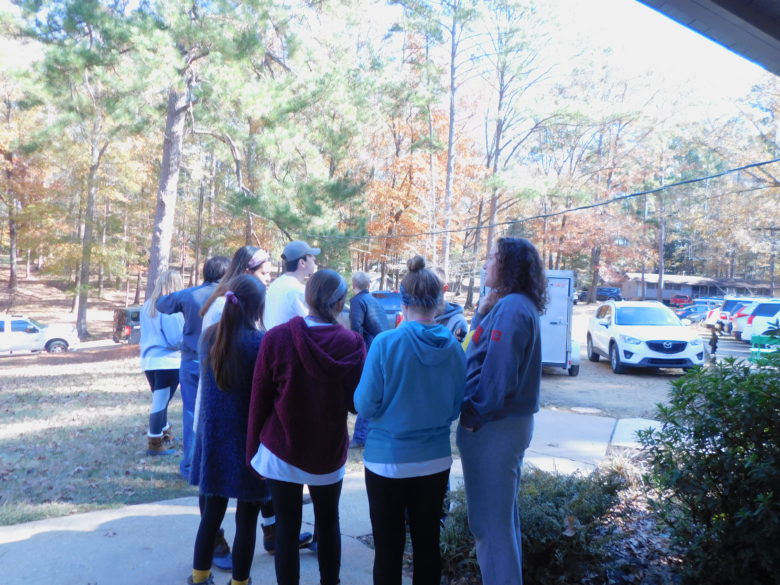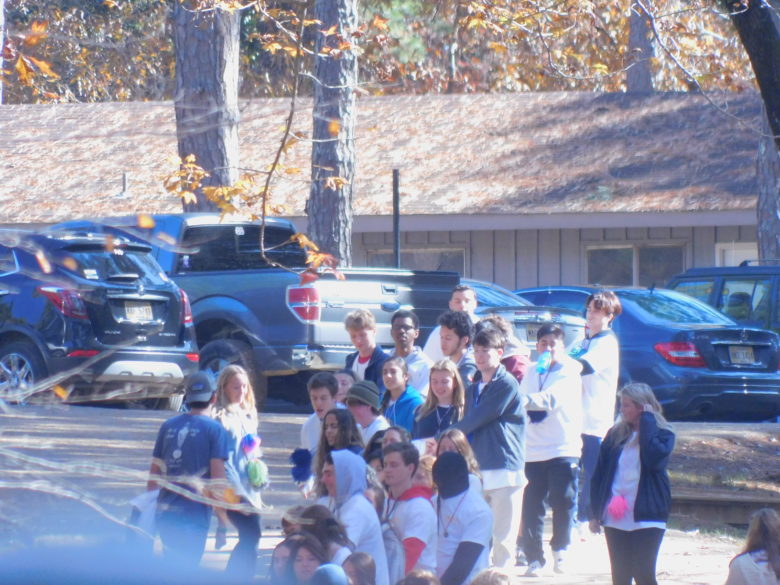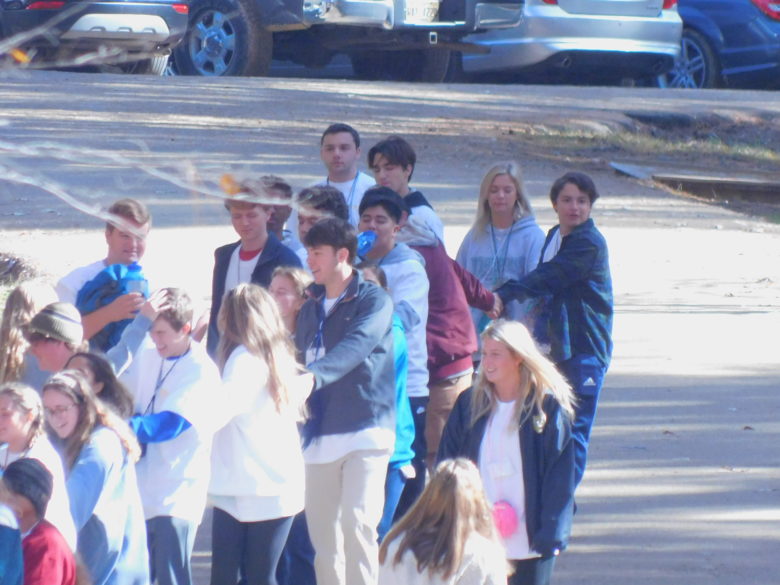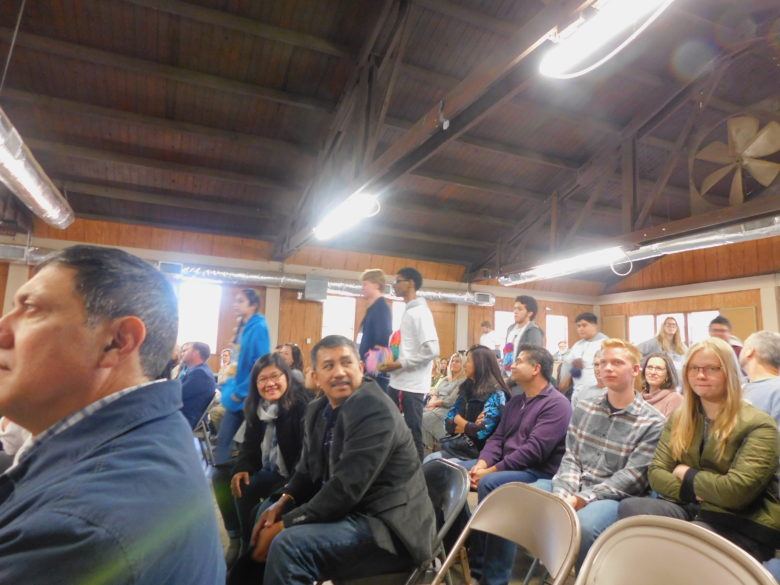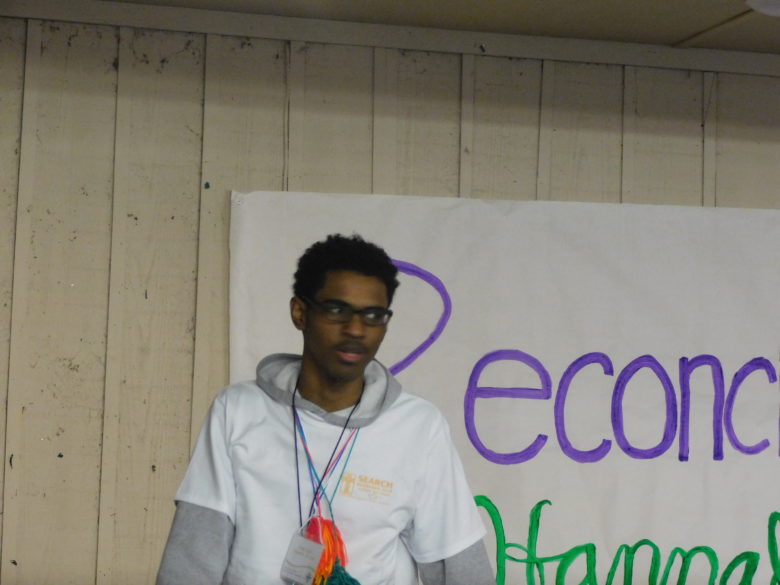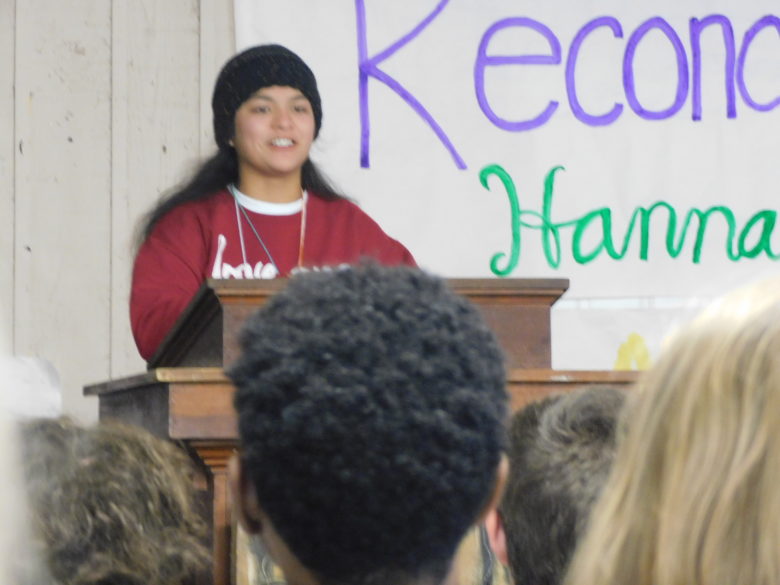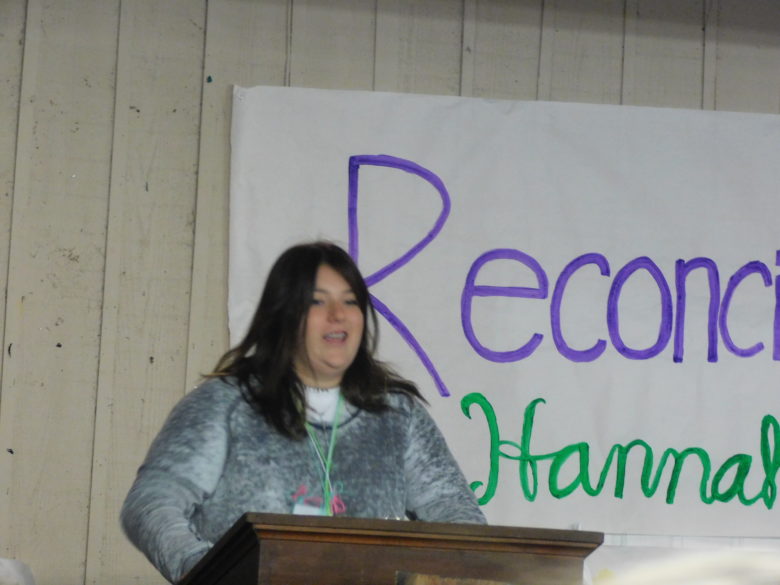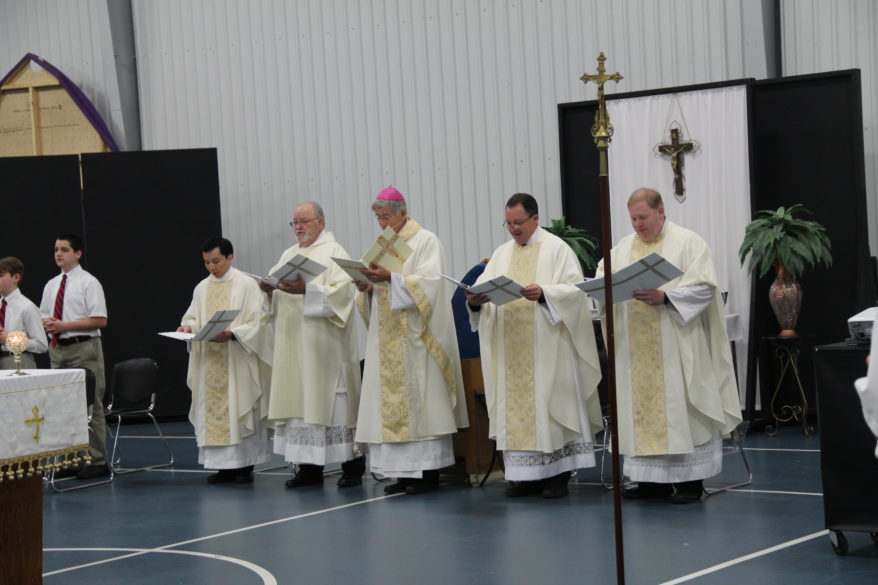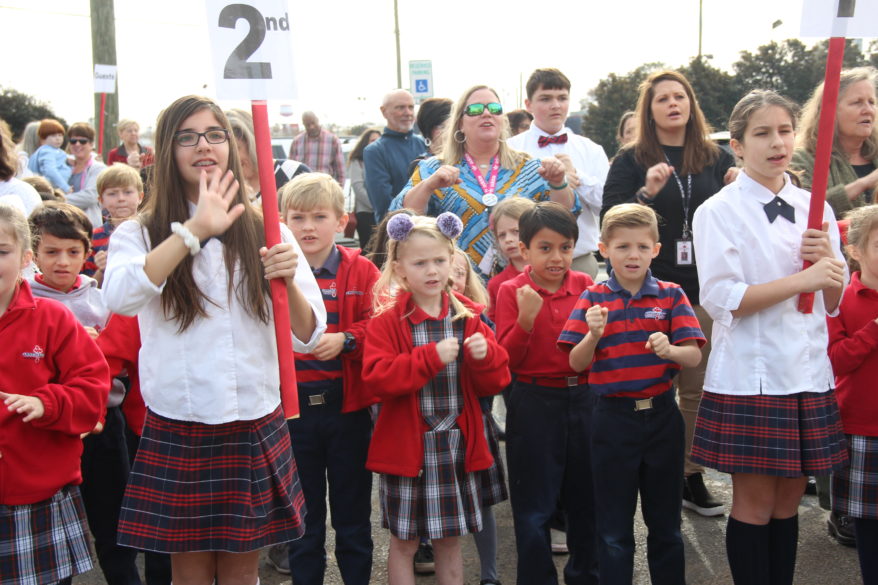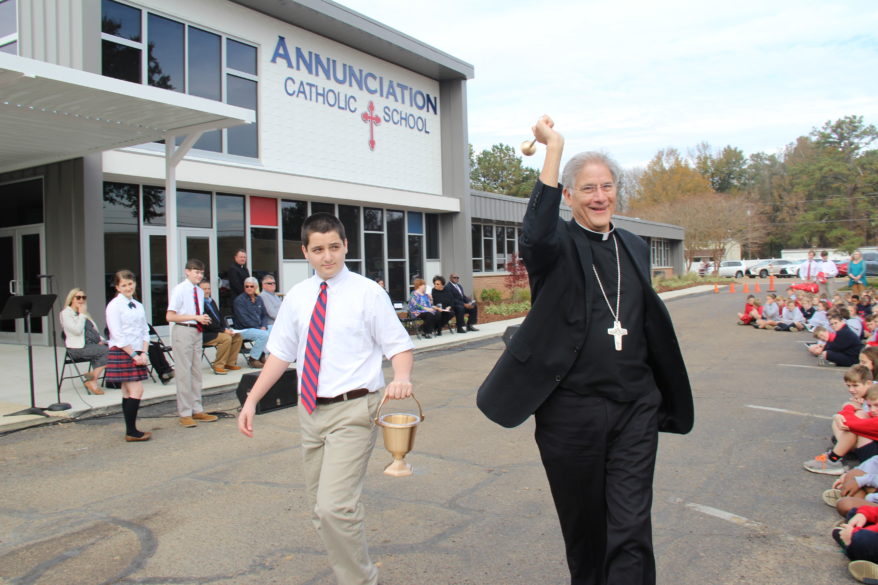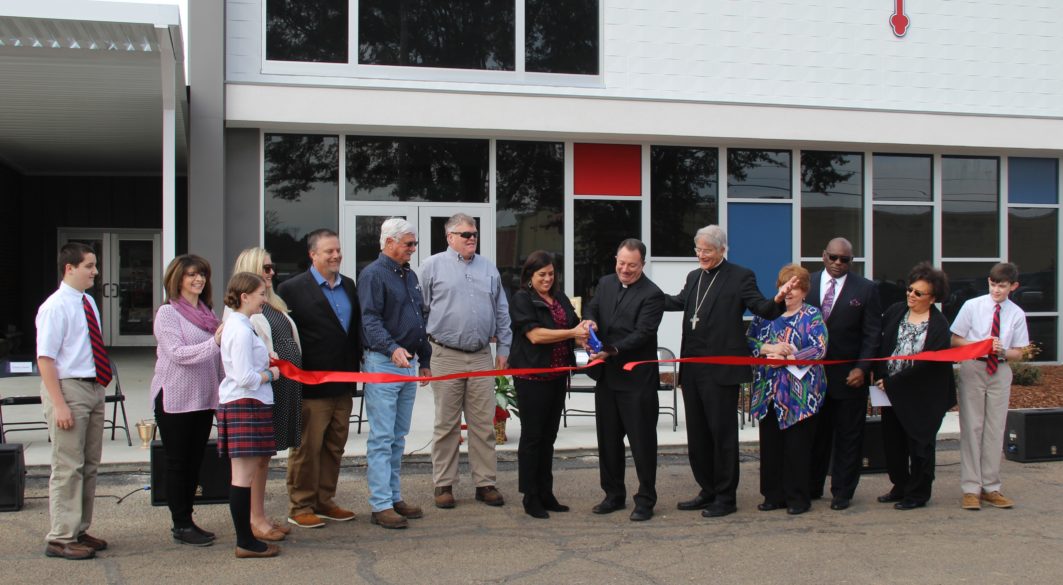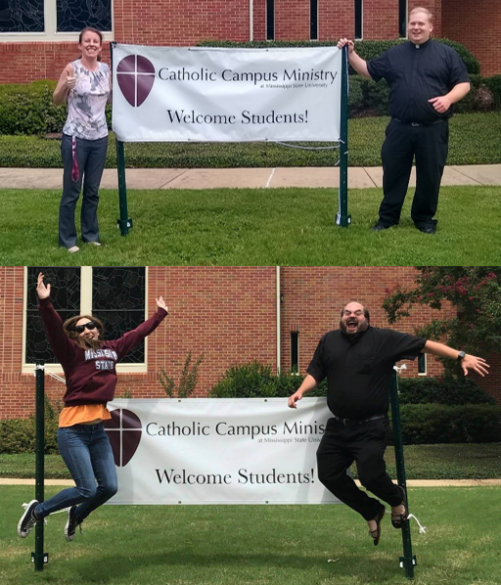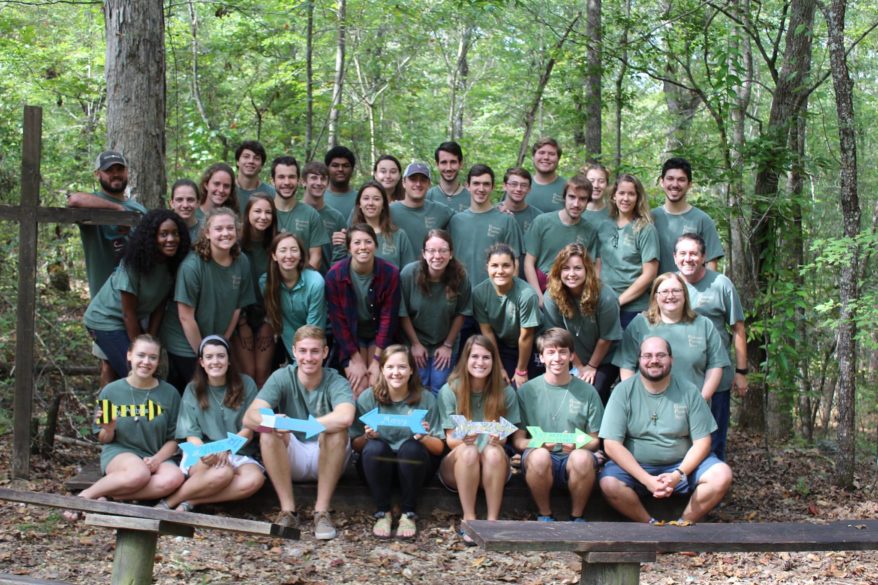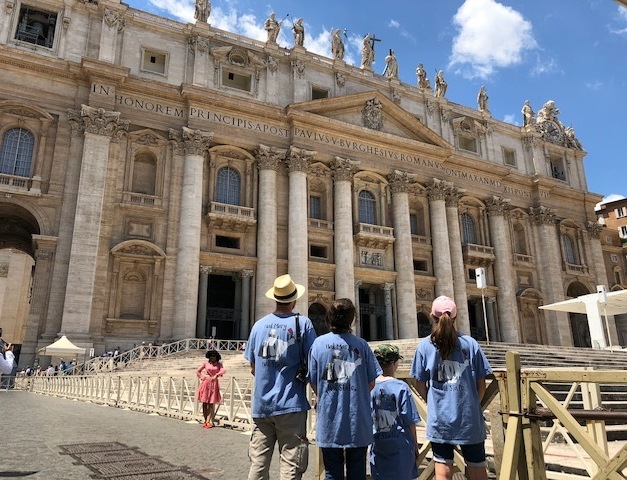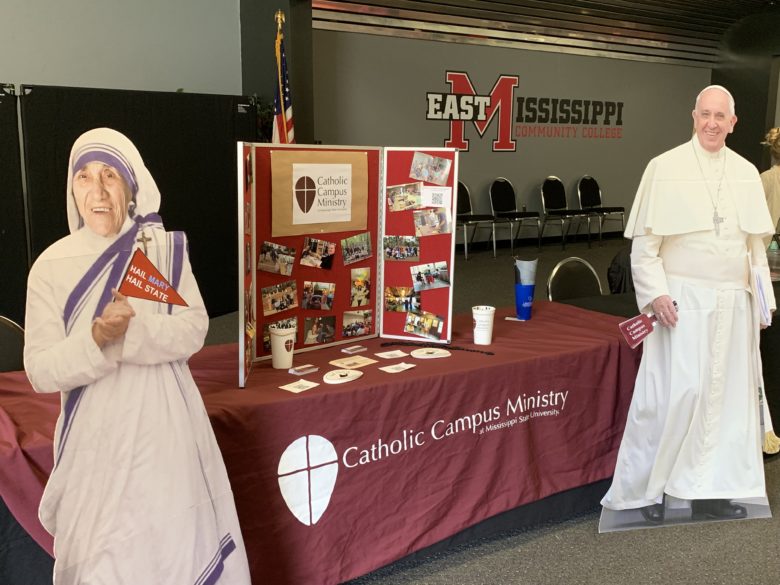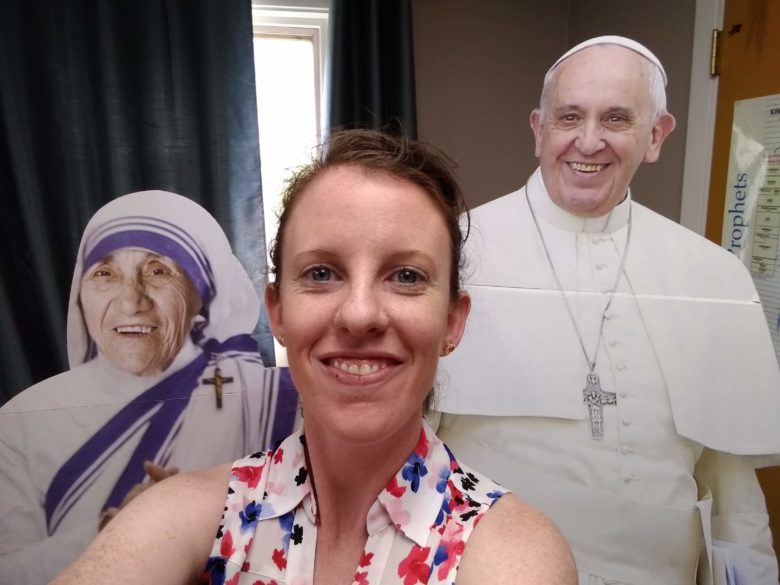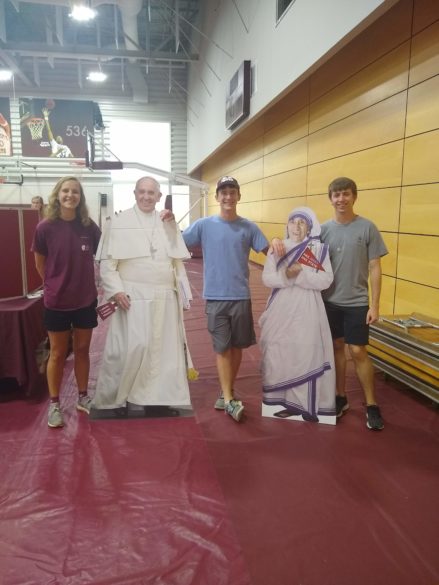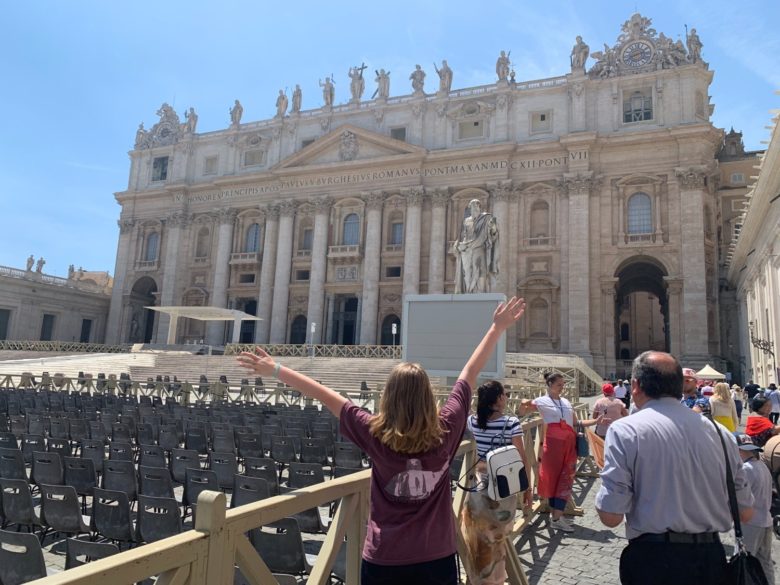GALLMAN – Youth gathered for a SEARCH retreat Nov. 22-24 at Camp Wesley Pines. SEARCH is a unique experience designed for juniors and seniors who have a strong desire to deepen their faith and relationship with Christ. Thirty-five “searchers” participated, coming from different parishes around the diocese. Each year the diocesan office of Youth Ministry has two SEARCH retreats, coordinated by Abbey Schuhmann and Ann and Jeff Cook. Thirty people, staffers and volunteers helped the searchers during their new experience of Christ. Among the volunteers were former searchers, there to serve and to help others to reach the fullness of spirituality. (left) Caroline Coffelt and Danielle Murphy, two adult volunteers welcomed searchers. (below) Searchers walk down a hill, eyes closed, during a “Trust Walk” exercise to learn how to rely on each other. (Photos by Berta Mexidor)
Author Archives: Tereza Ma
Seamos un faro de justicia y paz
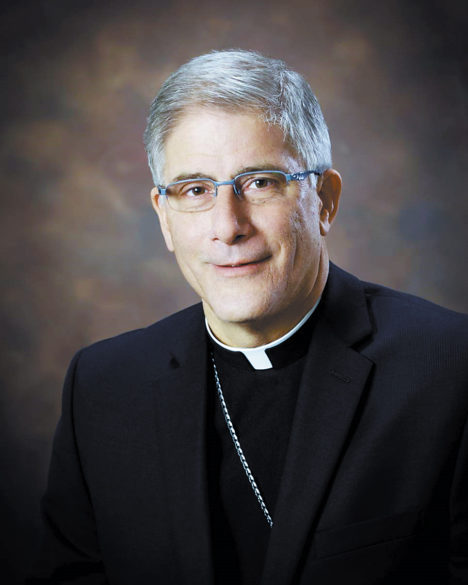
Por Obispo Joseph Kopacz
La Palabra de Dios en Adviento se desborda con una visión de justicia y paz, esperanza y reconciliación, solidaridad y comunidad para que este tiempo sea un anticipo de la eternidad. Al comienzo de esta temporada de expectativa y preparación, el primer domingo de Adviento, proclamamos el sueño de Dios para nuestro mundo según el profeta Isaías.
El siguiente pasaje de las Sagradas Escrituras se escuchó en toda la Iglesia Católica poco después que el Papa Francisco habló, con gran emoción, en los memoriales de Nagasaki e Hiroshima, sitios de las pesadillas nucleares que marcaron la culminación de la devastación al final de la Segunda Guerra Mundial:
“Éstas son las profecías que Isaías, hijo de Amós, recibió por revelación acerca de Judá y Jerusalén: En los últimos tiempos quedará afirmado el monte donde se halla el templo del Señor. Será el monte más alto, más alto que cualquier otro monte. Todas las naciones vendrán a él; pueblos numerosos llegarán, diciendo: «Vengan, subamos al monte del Señor, al templo del Dios de Jacob, para que él nos enseñe sus caminos y podamos andar por sus senderos.» Porque de Sión saldrá la enseñanza del Señor, de Jerusalén vendrá su palabra. El Señor juzgará entre las naciones y decidirá los pleitos de pueblos numerosos. Ellos convertirán sus espadas en arados y sus lanzas en hoces. Ningún pueblo volverá a tomar las armas contra otro ni a recibir instrucción para la guerra. ¡Vamos, pueblo de Jacob, caminemos a la luz del Señor!”
En estos monumentos, donde antes se abrieron las puertas del infierno, el Papa Francisco se solidarizó, una vez más, con la larga lista de profetas del Antiguo Testamento y papas de la era moderna y posmoderna, para clamar por justicia y paz con el ser humano.
San Juan XXIII escribió Pacem en Terris en 1963, menos de dos décadas después del final de la Segunda Guerra Mundial, abordando, en parte, el terrible desperdicio de recursos en la enloquecedora carrera armamentista, la bestia voraz del complejo militar-industrial, del cual el presidente Dwight D. Eisenhower advirtió en la década de 1950.
El 4 de octubre de 1965 el Papa Pablo VI, primer papa en comparecer ante las Naciones Unidas, habló de los horrores de la guerra y de la absoluta necesidad de la paz mundial. Él suplicó, con profunda emoción en su voz, “¡No más guerra! ¡Guerra, Nunca jamás!!
Dos años más tarde, escribió Populorum Progressio, el Desarrollo de los Pueblos, en el que abordó el terrible costo que el desarrollo, el despliegue y el uso de armas causaron en la familia humana, drenando los recursos necesarios para el desarrollo y matando el espíritu humano. Esta enseñanza apostólica exigía el pleno desarrollo de cada persona y de toda la persona. (n. 14)
El Papa Juan Pablo II y el Papa Benedicto vivieron directamente el infierno de la Segunda Guerra Mundial en Polonia y Alemania y a menudo hablaron con celo profético por la dignidad de la persona humana, la justicia y la paz. En el 50 aniversario de Populorum Progressio en 2017, el Papa Francisco estableció el Dicasterio para el Desarrollo Humano Integral, aplicando su pasión a la visión de Isaías, citada anteriormente. El Papa Francisco ama el concepto de integración y ve su necesidad urgente en todas las dimensiones de la vida. El desarrollo no puede restringirse al crecimiento material; significa integrar cuerpo y alma que encuentra su fuente en la Encarnación, el Dios-Hombre, Jesucristo. El desarrollo integral le da gloria a Dios y está en una relación con los demás. Desde lo personal a lo global, nuestro llamado es integrar a los pueblos de la tierra en armonía sostenible. La solidaridad y la subsidiariedad están en el corazón de la integración social de la economía, las finanzas, el trabajo, la cultura, la vida familiar y la religión al servicio de la red de la vida.
El Papa Francisco afirmó elocuentemente que “la vida humana es como una orquesta que suena bien si los diferentes instrumentos están acordes y siguen un puntaje compartido por todos: persona significa relación, no individualismo; afirma la inclusión, no la exclusión, la unicidad con una dignidad inviolable, en lugar de la explotación; libertad no coerción. El desarrollo humano integral es el camino del bien que la familia humana está llamada a recorrer.”
Más tarde, en noviembre de 2017, en Roma, en un simposio internacional llamado: “Perspectivas para un mundo libre de armas nucleares y para el desarrollo integral,” el Papa recordó a los participantes que el desarme integral solicitado por el Papa Juan XXIII en Pacem en Terris aún no se ha logrado. El pesimismo sombrío debe dar paso a un realismo saludable. El Papa Francisco declaró y citó la reciente declaración de las Naciones Unidas en 2015 que condena las armas nucleares como un medio ilegal de guerra, uniéndose a las filas de las armas biológicas y químicas prohibidas. Los catastróficos efectos humanitarios y ambientales serían impensables. El Santo Padre insistió en que la implacable carrera armamentista, nuclear y llamada convencional, “desvía recursos de la lucha contra la pobreza, la realización de proyectos educativos, ecológicos y de salud y el desarrollo de los derechos humanos. … No se pueden mantener las relaciones internacionales cautivas de la fuerza militar, la intimidación mutua y el desfile de arsenales. … El progreso que es efectivo e inclusivo puede lograr la utopía de un mundo libre de instrumentos mortales y de agresión, contrario a las críticas de aquellos que consideran idealista cualquier proceso de desmantelamiento.”
En el vuelo de regreso desde Japón, después de visitar Nagasaki e Hiroshima y al hablar sobre el uso de las armas nucleares, el Papa recordó a los periodistas “…Dije nuevamente que el uso de armas nucleares es inmoral; Esto debe ir al Catecismo de la Iglesia Católica. Y no solo el uso, sino también la posesión.”
Estados Unidos es la única superpotencia en este momento de la evolución de la humanidad y tenemos el potencial de ser un faro de mayor justicia y paz que puede guiar a las naciones del mundo en el camino del desarme integral. hacia el desarrollo humano integral, con el anhelo de Isaías, “¡Vamos, pueblo de Jacob, caminemos a la luz del Señor!”
Pope asks Catholics to set up, be enchanted by a Nativity scene
By Carol Glatz
ROME (CNS) – A Nativity scene is a simple reminder of something astonishing: God became human to reveal the greatness of his love “by smiling and opening his arms to all,” Pope Francis said in a letter on the meaning and importance of setting up Christmas cribs.
“Wherever it is, and whatever form it takes, the Christmas creche speaks to us of the love of God, the God who became a child in order to make us know how close he is to every man, woman and child, regardless of their condition,” the pope wrote in his apostolic letter, “Admirabile Signum” (“Enchanting Image”).
Pope Francis signed the short letter Dec. 1, the first Sunday of Advent, during an afternoon visit to Greccio, Italy, where St. Francis of Assisi set up the first Nativity scene in 1223.
When St. Francis had a cave prepared with a hay-filled manger, an ox and a donkey, he “carried out a great work of evangelization,” Pope Francis said, and Catholics must continue that work today.
“With this letter,” he wrote, “I wish to encourage the beautiful family tradition of preparing the Nativity scene in the days before Christmas, but also the custom of setting it up in the workplace, in schools, hospitals, prisons and town squares.”
At the heart of even the simplest Nativity scene, he said, there is a reminder of “God’s tender love.”
Then, he said, there is the fact that this baby is “the source and sustenance of all life. In Jesus, the Father has given us a brother who comes to seek us out whenever we are confused or lost, a loyal friend ever at our side. He gave us his son who forgives us and frees us from our sins.”
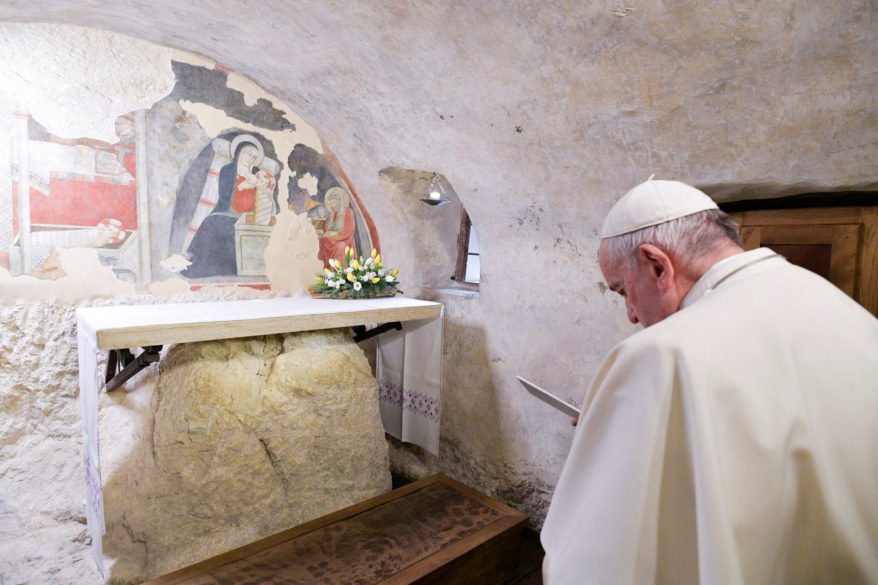
“To our astonishment, we see God acting exactly as we do: He sleeps, takes milk from his mother, cries and plays like every other child! As always, God baffles us. He is unpredictable, constantly doing what we least expect,” Pope Francis wrote. “The Nativity scene shows God as he came into our world, but it also makes us reflect on how our life is part of God’s own life.”
The simple shepherds, who were the first to go to the stable to see the newborn Jesus, are reminders that “the humble and the poor” are the first to welcome the good news, the pope said. “In a particular way, from the time of its Franciscan origins, the Nativity scene has invited us to ‘feel’ and ‘touch’ the poverty that God’s son took upon himself in the incarnation.”
That, in turn, calls Jesus’ disciples “to follow him along the path of humility, poverty and self-denial that leads from the manger of Bethlehem to the cross,” the pope wrote. “It asks us to meet him and serve him by showing mercy to those of our brothers and sisters in greatest need.”
Mary is a model of discipleship, faithfully accepting God’s will for her life and sharing him with others, inviting them to obey him. Joseph, too, accepts the role God assigned him, protecting the baby Jesus, teaching him and raising him.
And, of course, the pope wrote, “when, at Christmas, we place the statue of the Infant Jesus in the manger, the Nativity scene suddenly comes alive. God appears as a child, for us to take into our arms.”
The whole scene, he said, reminds adult Catholics of their childhood and of learning the faith from their parents and grandparents. Each year, it should be a reminder that the faith needs to be passed on to one’s children and grandchildren.
“The Christmas Cradle”
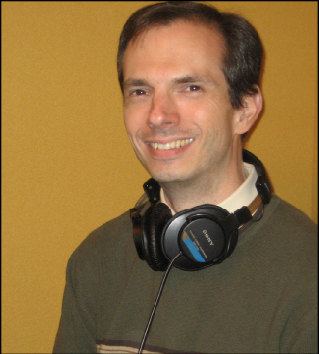
LIGHT ONE CANDLE
By Tony Rossi
Kids are used to getting presents for Christmas, and likely giving a few themselves. But Meadow Rue Merrill wants to expand their horizons by making it a fun family tradition to also give gifts to Jesus in a special way. That’s what inspired her children’s book The Christmas Cradle.
Merrill won a Christopher Award last year for her memoir Redeeming Ruth, about her adoption of a disabled orphan from Uganda. The mother of five joined me on “Christopher Closeup” recently to discuss The Christmas Cradle, which tells the story of a girl named Molly and her family who visit her Aunt Jenny to celebrate the holiday. Molly comes across a Christmas cradle in a box and asks her aunt its purpose. Aunt Jenny explains, “Growing up, we played a game to share God’s love with others. Each December, we sang carols, delivered meals, and visited people who were lonely. Then we wrote each act of love on a card and put it in the cradle as a gift for Jesus. On Christmas morning, we read the cards and prayed for each person we’d served.”
In writing the book, Merrill said she contemplated the questions, “How do we give a gift to Jesus, who has everything? I feel like we can do that best by giving gifts to other people in His name.”
Merrill doesn’t just approach that idea from the standpoint of a giver, but also a recipient of kindness. She recalls, “One of my favorite Christmas memories was when we truly had very little to give our kids, and a neighbor encouraged them to write letters to Santa. I was thinking, ‘Why? We don’t even have the ability to [afford anything].’ But on Christmas Eve, [this neighbor] invited our family over to her home, and there in the middle of her living room was a pile of Christmas gifts [for my family], including for the baby that I was pregnant with. As my husband and I brought those home that Christmas Eve, it really was the kind of magic that we all hope for – but somehow spending it on ourselves doesn’t make it happen. It’s when we find someone with a greater need than ourselves to give it away.”
Part of Merrill’s awareness of poverty stems from her experience adopting Ruth. She says, “Ruth won our hearts with her bright smile and the laughter in her eyes. It took a great amount of sacrifice to meet her physical needs, and yet the joy she brought us was so incredible.”
Unfortunately, Ruth passed away due to health complications, but her legacy lives on. Merrill says, “Getting to know Ruth and meeting her needs opened our eyes to the needs of children around the world, and in our own communities, who don’t have what they need. I realized how far our gifts, donations, and even time, can go when we invest those in the lives of someone else. Ruth changed our hearts forever in the way we look at things, and we want to reach out and share what we have with others.”
Merrill hopes that people don’t just read The Christmas Cradle, but act on it. She concludes, “When [families] have the opportunity to do a good deed for someone else, they can write it on a little piece of paper and put it in the cradle. Then on Christmas morning, we can remember those people who we served by taking out their names on the cards and praying for them.”
(Tony Rossi is the Communications Director for The Christophers, a Catholic media company. The mission of The Christophers is to encourage people of all ages, and from all walks of life, to use their God-given talents to make a positive difference in the world. Learn more at www.christophers.org.)
“Oh, Tidings of Con-on-flict and Joy, Conflict and Joy”
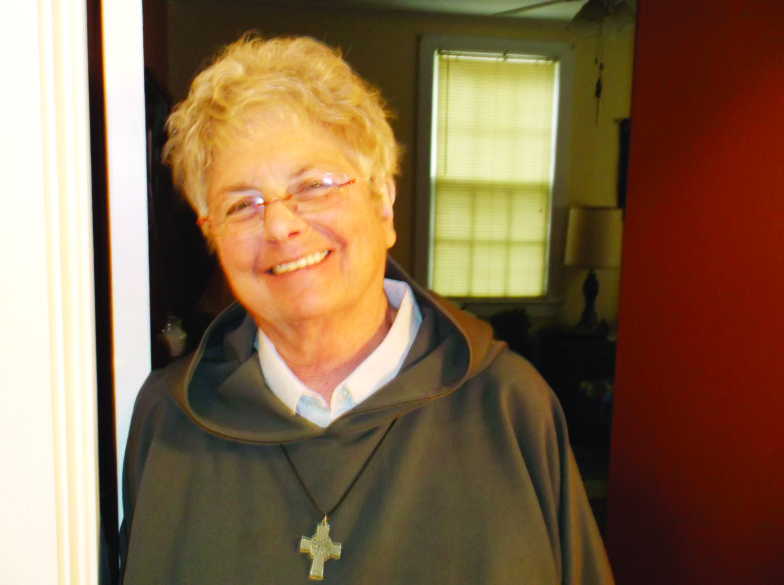
From the hermitage
By sister alies
Advent prepares us and heightens our longing. Our longing finds its place alongside our ancestors and God’s expressions of longing in the Hebrew Bible. Consider what our Catechism says: “The coming of God’s Son to earth is an event of such immensity that God willed to prepare for it over centuries. God makes everything converge on Christ: all the rituals and sacrifices, figures and symbols of the ‘First Covenant.’ God announces Christ through the mouths of prophets who succeeded one another in Israel. Moreover, God awakens in the hearts of pagans a dim expectation of this coming.” (522) Further, “When the Church celebrates the liturgy of Advent each year, she makes present the ancient expectancy of the Messiah, for by sharing in the long preparation for the Savior’s first coming, the faithful renew their ardent desire for Jesus’ second coming. By celebrating John the Baptist’s birth and martyrdom, the Church unites herself to his desire: ‘Jesus must increase, but I must decrease.’” (524)
Depending on how I live and celebrate Advent, I am at least either a pagan with a ‘dim expectation’ or part of the faithful with an ‘ardent desire’ to fully meet Jesus. I should like to be the latter, but alas I find within myself blocks and winding paths that seem to veer right away from an ardent desire. Lazy? Fearful? Hopeless? Whatever the blocks in me might be, or in you, they will eventually be removed by Jesus. I suspect that’s the point of Advent so that when we do come to reflect more deeply upon the story of Christmas our hearts might be ready to entertain some of its cost.
I was reflecting that Christmas is both joy and conflict when I came across a book I’d read some years ago, The First Christmas, What The Gospels Really Teach About Jesus’ Birth, by Marcus Borg and John Dominic Crossan. It made me continue to consider longing and conflict. Simply put, Jesus was a refugee Child forced from His country of birth, crossing the borders into a foreign land, Egypt. Other children were being killed and it would be some two years before the Christ Child returned home with Mary and Joseph to Nazareth.
This past year we have been plagued for many and various reasons with raids, separation of children from parents, immigrants and refugees being expelled, deported or jailed. In both cases we see the conflict and battle of speaking truth to power. There is nothing wrong with a just immigration policy. But for thousands of tiny children scared and made mute by the trauma we have to wonder how Jesus and His parents faired in Egypt.
Christmas, its story, facts and symbols, points to the conflict within and the conflict to come. Most of us have a pretty complete understanding of the Christmas story so our reflection upon it might be too swift. Let’s consider some of Matthew’s story you might have skipped over. Borg and Crossan share: “Mathew’s story sounds the theme of fulfillment but its emotional tone is ominous. Driven and dominated by Herod’s plot to kill Jesus, it is dark and foreboding. It speaks of the murderous resistance of the rulers of this world to the coming of the kingdom of God.”
I like the Catechism’s explanation of the ‘Christmas Mystery:’ “Jesus was born in a humble stable, into a poor family. Simple shepherds were the first witnesses to this event. In this poverty heaven’s glory was made manifest. The Church never tires of singing the glory of the night: The Virgin today brings into the world the Eternal and the earth offers a cave to the Inaccessible. The angels and shepherds praise Him and the magi advance with the star, for You are born for us, Little Child, God Eternal. To become a child in relation to God is the condition for entering the kingdom. For this we humble ourselves and become little … Christmas is the mystery of marvelous exchange.”
Equally the text in the Catechism tells us of the conflict midst the beauty: “the flight into Egypt and the massacre of the innocents make manifest the opposition of darkness to the light: ‘He came to His own home, and His people received Him not. (John 1:11) Christ’s whole life was lived under the sign of persecution. His own share it with Him. Jesus’ departure from Egypt recalls the Exodus and presents Him as the definitive liberator of God’s people.”
Venture deeper into Advent and begin the Christmas season, alert to both the joy and conflict and see how it plays out in our world and in our own hearts.
Blessings.
(Sister alies therese is a vowed Catholic solitary who lives an eremitical life. Her days are formed around prayer, art and writing. She is author of six books of spiritual fiction and is a weekly columnist. She lives and writes in Mississippi.)
Annunciation school celebrates expansion
By Katie Fenstermacher
COLUMBUS – Supporters of Annunciation school celebrated the institutions expansion on Thursday, Nov. 21 with a ribbon cutting ceremony and reception. Talks of expanding the campus have been ongoing for several years due to increasing enrollment every year. Annunciation Columbus enrollment has almost doubled in the last seven years and the school has seen a 97% increase in that time. After much discussion and research, school administration decided the best plan of action financially would be to build on the current location.
Annunciation began a capital campaign last spring to raise the $3 million needed to move forward with an expansion. The new expansion includes six new classrooms, a computer/STREAM lab, science lab, library and administrative offices. The front of the school also received a revamp. During the ceremony, representatives from each committee that worked on the expansion were present, as well as Bishop Joseph Kopacz and Catherine Cook, Superintendent, to cut the ribbon on this exciting new venture.
Principal, Joni House stated, “The construction of this new building is more than just walls and ceilings, it is the opportunity to continue our mission of higher learning in a Christ-centered environment. It gives us the opportunity to accept additional students each year and offer a more STREAM focused curriculum.”
“What an honor it is to work along so many others who have sacrificed personally and financially to provide an ever-expanding learning environment for our Annunciation Catholic School students and faculty. As we continue our school’s mission of building character, fostering community and creating lifelong learners, we can’t help but remember those sacrifices of so many in our school’s history. They formed the foundation that we have the privilege to be building on. The new opportunities that will be afforded our students and faculty is absolutely amazing, What a challenge and opportunity,“ said Father Jeffrey Waldrep, pastor of Annunciation school and church.
For more information, or to schedule a private school tour, please contact (662) 328-4479 or visit www.AnnunciationCatholicSchool.org.
Catholic campus ministry keeps faith alive in students
By Joanna Puddister King
STARKVILLE – Catholic faith is alive and thriving in colleges in the Golden Triangle area through an outreach of St. Joseph church. The church’s Catholic Campus Ministry (CCM) at Mississippi State University also serves students at East Mississippi Community College and the Mississippi University for Women.
Students are the heart of this peer-led organization that believes college is a time for growth and formation for the whole person – body, mind and spirit.
College is truly a time for social growth and community, an avenue that CCM excels at with – free food, a language every college student understands. Tuesday Night Dinner (or TND as it is more affectionately known) hosted at St. Joseph is a great way to feed hungry students bellies and give them spiritual fuel to get them through the week by hosting interactive talks ranging from relationships, vocations, apologetics and more.
“When I first moved to Mississippi, I knew approximately three people here. I … learned about Tuesday Night Dinner (TND) and free food – every college student’s dream! As I started going to TND, I met lots of new people, learned about other CCM happenings and joined in on events and volunteering,” says Mississippi University for Women senior, Maggie Rodriguez.
“Over the past few years CCM has become my second family, a home away from home.”
In addition to free food, CCM has two important Catholic figures in their corner – Mother Teresa and Pope Francis – well, life-size cut-outs that is. The pair have been a main feature since the summer at campus events.
“At the New Maroon Camp, a freshman orientation type set of events, we were the first table people saw as they came into the auditorium filled with representatives from the clubs at MSU. With the cowbell in hand, Pope Francis received lots of smiles from Catholics and non-Catholics alike; likewise, Mother Teresa and her ‘Hail Mary, Hail State’ flag got plenty of positive feedback,” said director of campus ministry, Meg Kanatzar.
“They’re fabulous conversation starters! People come over just to take selfies with them.”
The “Hail Mary, Hail State” phrase ignited a powerful fundraiser that has Catholic Mississippi State fans near and far sporting the phrase on the groups signature t-shirt. Former student Joseph Kerstiens helped come up with the idea for the hugely popular shirt, with the silhouette of Saint Pope John Paul II with a cowbell and rosary in hand, with the slogan.
“We really wanted to have something that incorporated MSU and the Catholic faith, and it wasn’t long before we had the slogan ‘Hail Mary, Hail State,” said Kersteins.
Though there are a lot of fun and games, like Catholic intermural sports and monthly trivia night, the group finds time to allow students to grow deeper in their relationship with Christ with Eucharistic adoration and Bible study, in addition to service to others.
Mini-mission trips to Smith Park in Jackson with Deacon John McGinley is one way the group ministers to others. Often times, the group come on a Sunday so that they can invite the people they meet to Mass at the Cathedral of St. Peter. They also make plastic bags into beds and pillows and distribute to those that need them.
In addition to serving the homeless in Jackson, the group also ministers to their local community with volunteering at Habitat for Humanity, working in the St. Joseph food pantry and serving home-bound individuals with a food box delivery on a monthly basis.
“I want to give back to the community that has given me so much over the past four years,” says co-president of CCM, Jeremy Irwin.
“I had a tough time sophomore year and my CCM family still managed to make my time here at State enjoyable, while still growing in my faith. My hope is that I am able to help bring others the joy CCM has brought me, through Christ.”
That joy is the fuel that keeps director of the campus ministry, Meg Kanatzar going.
“Seeing someone come back on fire for their faith after attending a retreat or observing one student counsel a peer in a difficult time, or entering a chapel or church filled with students praying during Adoration. There are countless moments when I am privileged to witness students making God a priority in their lives,” said Kanatzar.
50 years since White House conference on food, hunger issues remain
By Carol Zimmermann
WASHINGTON (CNS) – Fifty years ago, the White House sponsored a Dec. 2-4 conference on food, nutrition and health designed to set the groundwork for a national nutrition policy and to advise President Richard Nixon on the best ways to eliminate hunger in the U.S.
The conference succeeded in initiating policies to improve school lunch programs and nutrition education and to give more consumer protection – which led to the nutritional labeling food buyers are now accustomed to.
The conference also helped develop the Women, Infants and Children program, which offers supplemental food assistance to low-income pregnant women and mothers and children up to age 5, and it paved the way for the first major expansion of the Supplemental Nutrition Assistance Program (SNAP), which helps low-income individuals and families buy food.
Fast forward 50 years and food policy advocates still have a lot on their plates, in efforts to address food insecurities as well as growing food-related epidemics of diabetes and obesity. They also want to ensure policies that took shape 50 years ago do not face pending cuts by President Donald Trump’s administration.
Several of the event panelists cited troubling statistics on hunger. Notably, the U.S. Department of Agriculture’s 2019 Household Food Insecurity report said more than 37 million people in the U.S. struggle with hunger.
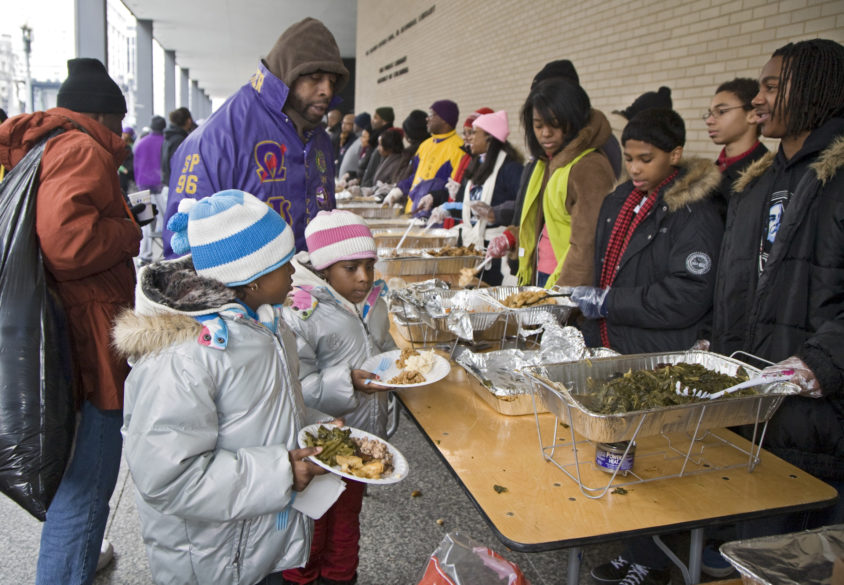
Other statistics they shared, compiled by Hunger Free America, include:
– 14.3 million households were food insecure with limited or uncertain access to enough food.
– More than 11 million children are food-insecure.
– Many households that experience food insecurity do not qualify for SNAP and rely on local food banks.
No one needs to tell these facts to those who work in public policy at Catholic Charities USA or its local agencies providing food to those in need.
Anthony Granado, vice president at Catholic Charities USA, said there are several food policies that have the support of Catholic Charities, the U.S. Conference of Catholic Bishops, the Catholic Health Association, Catholic Rural Life and the Society of St. Vincent de Paul.
Those groups submitted a joint comment objecting to the Trump administration’s proposal to tighten eligibility standards for SNAP that would cause about 3.1 million to lose food stamp benefits.
The comment, submitted Sept. 23, called SNAP the “first line of defense against hunger.”
They also said the proposed changes to SNAP would bring more people to charities for help when they are already feeding millions each year.
“Our organizations already struggle to meet the needs in our communities and are forced to turn away many for lack of resources. The proposed rule, if implemented, will only add to a demand that we cannot meet,” their comment letter said.
Lizanne Hagedorn, director of Nutritional Development Services for the Archdiocese of Philadelphia, knows all about food needs and hasn’t seen them decrease by any means.
As the head of agency that administers local federally funded child nutrition programs and a community food program, Hagedorn said those who come for help are not always atypical; in recent years the agency has seen more senior citizens and college students. She also has seen a shrinking pool of volunteers to serve those in need at food pantries.
“It’s in our blood as Catholic Christians to be good stewards of food and money and to bring everybody along,” Hagedorn said. “Not in an overbearing way but understanding ‘there but for the grace of God go I.'”
Elsa Baughman – a Catholic Messenger
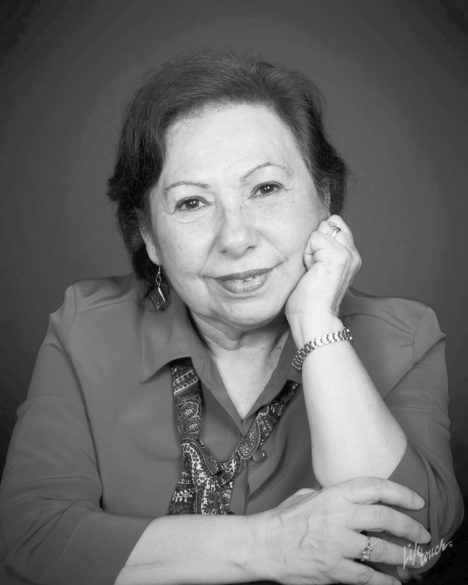
By Berta Mexidor
JACKSON – Before being known as Mississippi Católico, the Spanish-speaking newspaper of the Diocese of Jackson was published as El Mensajero Católico (The Catholic Messenger) for more than ten years.
With the consent of Bishop William Houck, the action of several people who recognized the need to communicate in Spanish with a growing community and a team dedicated to informing, the idea materialized, and on Oct. 10, 1997, the first edition of The Catholic Messenger came to light, more than 22 years ago.
As a protagonist and record keeper of the history is Elsa Baughman. She began working in 1996, for the diocesan newspaper, then called Mississippi Today. Baughman, Venezuelan by birth, graduated of Journalism at the University of Zulia in Venezuela,and with a master’s degree in Mass Communication from the University of Southern Mississippi (USM). A mother and grandmother, Elsa (as everybody knows her), brought her rich experience, culture and the desire to break stereotypes to the diocesan newspaper.
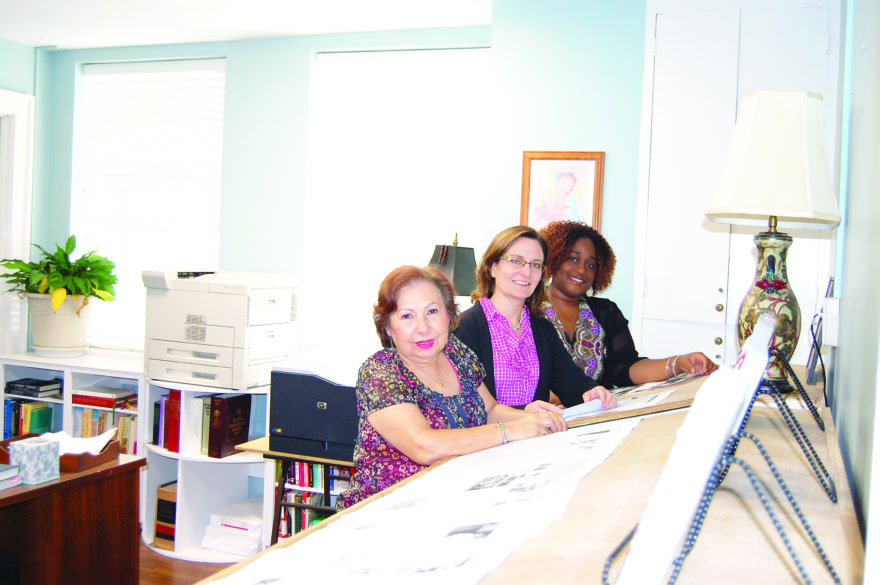
Elsa arrived in Mississippi in 1976 when there were few Hispanics in the state. After graduating from USM, getting married and working in several international companies and being a Spanish teacher, she started working at Mississippi Catholic.
In December 1979, Bishop Joseph B. Brunini was the main celebrant of the first Mass to Our Lady of Guadalupe in the Cathedral of San Pedro. Father Mario Vizcaino, SchP. founder of Southern Pastoral Institute (SEPI), auxiliary Bishop William Houck and father Paul Madden were co-celebrants. From there, the tradition of the Spanish Mass was established and the need to serve the growing Latino community.
Since 1982 Rogelio Solis reported Spanish activities to Mississippi Today. Among many people who contributed to promoting the newspaper in Spanish, it is Janna Avalon, who for more than 40 years directed Mississippi Catholic, Fabvienen Taylor, who wrote the first article about the differences and similarities of Latinos, Elizabeth Ayala, who wrote about the sacraments, Sister Patricia Brown, who founded and directed the Hispanic Ministry, Sister Day, Ligia Fenton, Susan Falkner and the priests Jerry Mattingly of Hazlehurst, Richard Smith of Forest, Anthony Quyet of Forest, Maureen Smith, Diocesan Communications Director and brother Ted Dausch who worked for 20 years as coordinator of Hispanic Ministry. All of them; and many more, who always supported the Hispanic celebrations and their dissemination in the Spanish newspaper.
As a committed editor, reporter and Catholic, everyone met Elsa. Even today, after her retirement, Elsa follows the events of her community and she can be seen taking pictures at St. Therese Parish in Jackson. She currently enjoys her free time with her husband, Brian, their daughters, Carla and Verónica and their grandchildren, Arianna and Roman.
“For me, working in the newspaper was a dream come true. Having met so many people and priests, traveling throughout the state and working for three bishops – William Houck, Joseph Latino, and Joseph Kopacz – were wonderful experiences. … One of my best memories, that I keep with great affection, it was the trip to the Saltillo Mission in Mexico, by invitation of Bishop Kopacz, after having reported for many years about the importance of this mission to the diocese,” Elsa concluded.
Hispanic Ministry in Mississippi, a history
By Sister Patricia Brown and Elsa Baughman
JACKSON – The first celebration of the anniversary of the Virgin of Guadalupe in Jackson was 40 years ago, it was not only a success but also the seed that, over time, began the creation of the Hispanic ministry in the Diocese of Jackson.
On Sunday, Dec. 16, 1979, at 4:30 p.m. Bishop Joseph Brunini, auxiliary Bishop William Houck, Father Mario Vizcaino, SchP., founder of Southern Pastoral Institute (SEPI), and Father Paul Madden celebrated the first Mass in Spanish at St. Peter’s Cathedral. About 200 Hispanics from the Jackson area attended that celebration.
In January 1980, a pastoral council was organized in Jackson, meeting regularly and the Sunday Mass was celebrated at St. Peter’s Cathedral in the afternoons. Religion and English classes were offered, social and religious parties were held, and a newsletter was distributed to 95 families.
The United States Census in 1980 indicated that the population of Hispanics in Mississippi was less than one percent. Many of these were migrant farm workers dispersed in the Delta area and in chicken processors in the center of the state.
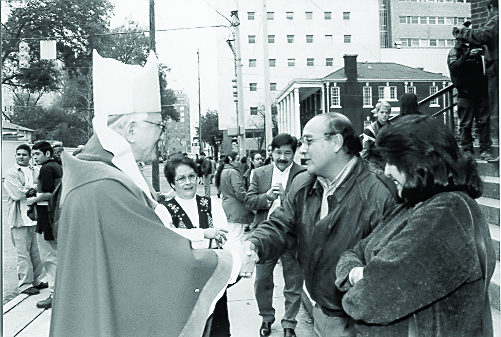
Although Sister Thea Bowman did not speak Spanish, she helped the Hispanic community to continue celebrating the Eucharist in Spanish and their activities in the Jackson area.
During the 1980s, Father Michael Flannery and Father Richard Smith assisted migrant workers, near Clarksdale.
The 1990 census counted 9,752 Hispanics in the 65 counties of the diocese. The Diocese of Jackson asked Sister Patricia Broderick for a study of the Hispanic community and a plan to meet their needs. The suggestions of that proposal, written in November 1990, remain valid today, only the numbers have increased, and the needs have multiplied.
In 1991, Father José Daniel López, began celebrating Sunday Mass at St. Peter’s Cathedral. Deacon Roberto Jiménez began assisting Father Lopez, and Father Anthony Quyet, in St. Michael parish in Forest, began celebrating Mass in Spanish on April 7, 1991. Prior, Father Madden celebrated Mass in Spanish at the residence of the Echiburu family in Morton.
In 1993, Sister Jeroma Day began visiting Hispanic homes in Rosedale. Gene and Mary Helen Grabbe, lay missionaries of the Glenmary order, formed a stable community Hispanic family in the St John Neumann Mission. In September 1994, the Diocese of Jackson established the Office of the Hispanic Ministry under the direction of Sister Patricia Brown. Sister Patricia Godri arrived in Carthage in September 1994 to work as a pastoral minister in St. Anne’s Church. In 1995 the missionaries of the Glenmary Order sent Father Francisco Pellissier to serve as a sacramental minister in six counties in northeast Mississippi. On Dec. 17 that year, Father Pellissier celebrated the first bilingual mass at San Christopher Mission in Pontotoc.
Father Steve Pawelk, Sister Nancy Schreck, Father Jerry Peterson and Father Gerry Richardson were some of the first religious who served in the Hispanic community in New Albany. Sisters Patricia Sullivan, Rosemary Empen and Kris Vorenkamp oversaw services in Chickasaw and Calhoun counties. In 1996, the Catholic Center in Morton was inaugurated. The first Spanish mass in Ripley was celebrated on Dec. 12, 1997. Father Jerry Mattingly started Mass in Spanish at San Martín Mission in Hazlehurst since 1997.
In 1999, Christian Brother Ted Daush assumed the leadership the Hispanic Ministry until June of this year, giving twenty years to this ministry, supported by Guadalupean Missioneries sisters and parish leaders. Last July the Diocesan Intercultural office was created where Hispanic and Black Catholic Ministries were merged.
The establishment of the Hispanic ministry in the Diocese of Jackson allowed the increase of religious, social and cultural services to the Hispanic community in the 65 counties of the diocese.
(This article was published in Catholic Messenger on Dec. 17, 1999. Elsa Baughman updated it for this edition. Read the article in its entirety on MississippiCatholic.com.)


